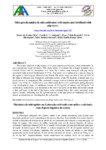Please use this identifier to cite or link to this item:
http://www.alice.cnptia.embrapa.br/alice/handle/doc/930854| Title: | Nitrogen dynamics in soils cultivated with maize and fertilized with pig slurry. |
| Authors: | SILVA, D. de F.  ANDRADE, C. L. T.   RESENDE, A. V.   HICKMANN, C.   AMARAL, T. A.   ALVES, M. E. B.   |
| Affiliation: | CAMILO DE LELIS TEIXEIRA DE ANDRADE, CNPMS; ALVARO VILELA DE RESENDE, CNPMS. |
| Date Issued: | 2012 |
| Citation: | Revista Ambiente & Água, Taubaté, v. 7, n. 1, p. 9-23, 2012. |
| Description: | The proper disposal of pig manure is of great importance because, when mishandled, it can contaminate water resources. This study aimed to evaluate the nitrogen dynamics in a Cerrado Oxisol and its absorption, over time, by a maize crop managed with pig slurry associated with mineral fertilization (N P K). The study was conducted at a private farm, in the region of Sete Lagoas, Minas Gerais, Brazil. The maize crop was able to recover 62% of the mineral nitrogen that entered the soil-plant system, while 9% leached as nitrate and, to a lesser amount, as ammonium. The maximum average content of nitrate and ammonium of 92 kg ha-1 and 43 kg ha-1, respectively, was observed in the 0 to 0.3 m soil layer during the early crop development stage. A minimum content of 5.8 kg ha-1 of nitrate and 9.0 kg ha-1 of ammonium, respectively, was measured at the end of the cycle. In addition, the nitrate content at that soil layer, at the end of the maize cycle, remained below the values measured at the native Cerrado, indicating that the agricultural use of the land poses no additional risk to the nitrate accumulation and leaching into the soil profile. Resumo: A destinação adequada dos dejetos suínos é de grande relevância, pois quando mal manejada, pode provocar contaminação de recursos hídricos. Este trabalho teve como objetivo avaliar a dinâmica do nitrogênio no perfil de um Latossolo sob Cerrado e a sua absorção, ao longo do tempo, pela cultura do milho, manejada com uso de dejetos líquidos de suínos, associado à adubação mineral (N P K). O estudo foi realizado em uma propriedade particular da região de Sete Lagoas, MG, Brasil. A cultura recuperou 62% do nitrogênio mineral que entrou no sistema solo-planta, enquanto 9% lixiviou na forma de nitrato e, em menor quantidade, na forma de amônio. Teores médios máximos de nitrato e amônio de 92 kg ha-1 e de 43 kg ha-1, respectivamente, foram observados na camada 0-0,3 m no início do desenvolvimento da cultura. Conteúdos mínimos de 5,8 kg ha-1 de nitrato e de 9,0 kg ha-1 de amônio, foram medidos no final do ciclo. Além do mais, os teores de nitrato naquela camada, ao final do ciclo da cultura do milho, mantiveram-se abaixo dos valores observados do Cerrado nativo, indicando que o uso agronômico da terra não ofereceu risco adicional de acúmulo e lixiviação de nitrato no perfil do solo. |
| Thesagro: | Lixiviação Zea Mays |
| NAL Thesaurus: | Corn |
| Keywords: | Contaminação ambiental |
| DOI: | 10.4136/1980-993X |
| Type of Material: | Artigo de periódico |
| Access: | openAccess |
| Appears in Collections: | Artigo em periódico indexado (CNPMS)  |
Files in This Item:
| File | Description | Size | Format | |
|---|---|---|---|---|
| Nitrogendynamics.pdf | 309,67 kB | Adobe PDF |  View/Open |









